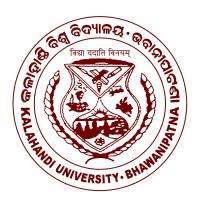General Information
Kalahandi University, located in Bhawanipatna, Odisha, represents the elevation of a long-standing institution to university status. It's a public State University, established relatively recently (around 2019-2020) by the Government of Odisha Act. Crucially, it was formed by upgrading the erstwhile Government Autonomous College, Bhawanipatna, which itself had a history dating back to 1960. This upgrade signifies a commitment to expanding higher education access and quality in this historically significant region of Western Odisha.
Its mission is focused on providing comprehensive higher education, promoting research, and contributing to the socio-economic development of the Kalahandi region and beyond. It primarily functions as a teaching and affiliating university, offering postgraduate programs on its campus while likely overseeing undergraduate education in affiliated colleges within its jurisdiction (transitioning affiliations from Sambalpur University for colleges in its designated area).
Key Recognitions:
Established by an Act of the Odisha State Legislature.
Recognized by the University Grants Commission (UGC).
As a newly upgraded university, its NAAC accreditation cycle as a university would be upcoming. However, the predecessor Government Autonomous College likely held a respectable NAAC grade.
Holds necessary approvals from bodies like NCTE (Education) for relevant programs.
MCI Recogination
Permitted u/s 26 (a) (b) ,28(1) (2) and 61(2) of NMC Act. 2019 for the A/Y 2023-2024. Annual renewal permission granted for 100 MBBS seats for AY 2024-25
Campus Facilities
The Campus: Building on an Established Foundation
Kalahandi University operates from the campus of the former Government Autonomous College.
Location: Situated in Bhawanipatna, the district headquarters of Kalahandi, Odisha.
Campus Vibe: Expect a campus with a blend of older infrastructure (from its college days) and newer developments reflecting its university status. It likely possesses a reasonably spacious layout with academic blocks, administrative offices, and green areas, typical of established government colleges in Odisha.
Infrastructure & Facilities: Leveraging its history, the campus likely includes:
Academic Departments: Buildings housing various postgraduate departments (Arts, Science, Commerce).
Library: A central library with a significant collection built over decades, serving UG and PG students.
Laboratories: Functional labs supporting practical work in various science disciplines (Physics, Chemistry, Botany, Zoology, Computer Science, etc.).
Learning Spaces: Lecture halls, seminar rooms, classrooms.
Hostels: Existing hostel facilities for students.
Amenities: Administrative offices, potentially a health center, canteen, sports grounds.
Hospital & Medical Facilities
Leading tertiary care hospital attached to the institution
Healthcare Connection: Focus on General Academics
Kalahandi University does not have its own constituent Medical College offering the MBBS degree, nor does it operate a large general teaching hospital for that purpose. Its academic focus lies firmly in the traditional domains of Arts, Sciences, Commerce, and potentially Education or Computer Applications. Medical colleges in the region (like the one in Bhawanipatna) would be affiliated with the state's health university system. The university likely provides basic first-aid or primary care through a campus health unit.
Fee Structure
State University Affordability
Fee Structure: State University Affordability
Being a State University evolved from a government college, the fees for regular, aided programs offered directly on the Kalahandi University campus are expected to be highly affordable. Self-financed courses, if any, would have higher fees.
City Details
Hostel & Mess
Campus Living: Hostel Life in Bhawanipatna
Kalahandi University provides residential facilities inherited from its time as a government college.
Availability: Yes, the university has separate hostels for boys and girls within the campus premises. Allotment is usually based on merit, category, and distance, with capacity likely catering primarily to PG students on campus.
Facilities: Expect basic furnished accommodation (mostly shared rooms), common rooms, dining halls (messes), security, warden supervision, and essential amenities.
Mess System: Each hostel likely operates its own mess providing regular meals, often featuring regional Odia cuisine, managed on a dividing or fixed-rate system.
Cost: As a state university, the combined cost for hostel accommodation and basic mess food is generally expected to be very affordable. The total annual charges are likely highly economical, possibly in the ₹15,000 - ₹30,000 range (Needs precise confirmation from the hostel authorities).
Miscellaneous
Admissions & Career Pathways: State Processes & Regional Focus
Getting Admitted:
University Entrance Test (Common PG Entrance - CPET Odisha): Admission to most Postgraduate (PG) courses (MA, MSc, MCom, MBA, MCA, etc.) offered directly by Kalahandi University departments is likely through the Common PG Entrance Test (CPET) conducted by the Odisha State Higher Education Council for all state public universities. Candidates apply centrally via SAMS Odisha and give university/subject preferences based on their CPET rank during counselling.
Affiliated Colleges (UG/PG): Admissions to UG courses (BA, BSc, BCom) and some PG courses in affiliated colleges are managed through the SAMS (Student Academic Management System) portal run by the Odisha Higher Education Department, based primarily on merit in the qualifying examination (Class 12/Graduation).
B.Ed: Admission is likely through the Odisha B.Ed Entrance Test.
Ph.D.: Admission involves a University Entrance Test followed by interviews. NET qualified candidates might be exempted from the test.
Always follow the official Kalahandi University admission notifications and Odisha State Higher Education Council (SAMS/CPET) websites for the latest procedures.
Career Support (Placements):
Focus: Kalahandi University likely has a placement cell, possibly inherited and developing from the autonomous college structure. Career paths for many graduates, particularly from Arts, Science, and Commerce, often lead towards state government jobs (OAS, banking, administrative roles), teaching positions (School/College level after B.Ed/NET/Ph.D.), entrepreneurship, or pursuing further academic research relevant to the region.
Campus Placements: Direct campus placements might occur for professional courses like MBA or MCA (if offered strongly). Recruiters would likely include regional companies, banks, educational institutions, and NGOs operating in Western Odisha.
Outcomes: Placement success varies. Average packages from campus drives, where available, are expected to be modest, potentially in the ₹2 LPA to ₹4 LPA range. The university's key role is in providing accessible higher education and serving as a feeder for regional employment and state-level competitive exams.
Information for NRI / Foreign Nationals
State universities in regional locations like Kalahandi University typically have limited, if any, specific provisions for NRI/Foreign Nationals compared to central or large private universities.
General Policy: Kalahandi University, as a State University primarily serving the regional population, likely does not have a dedicated, reserved NRI quota or extensive mechanisms for admitting foreign nationals into its regular programs. Admissions are governed by Odisha state domicile rules and standard Indian constitutional reservations.
Possibility for Specific Schemes: Admission might be possible through specific Government of India scholarship schemes (like ICCR) if the university is approved under such programs, or potentially on supernumerary seats if specific university regulations permit, likely requiring direct application and potentially higher fees.
Recommendation: Given the university's nature and typical admission practices, a standard NRI channel is improbable. The most reliable action is direct inquiry. Contact the Kalahandi University admission office or the Chairman, PG Council. Ask explicitly if any provision exists for NRI/Foreign National admissions for your course of interest, detailing the eligibility, required documentation, procedure, and fee structure.
Collage Images Gallery
Facilities & Campus Life
Well-equipped Library
Experienced Faculty
Computer Lab
Sports Activities
Heritage Campus
Frequently Asked Questions
Why Consult With Us?
- 15+ years of experience in medical education counseling
- 5000+ students successfully guided
- 50+ partner universities worldwide
- Free initial consultation with no obligation














